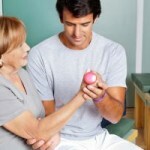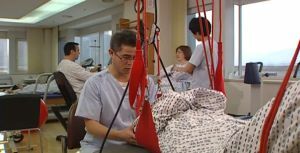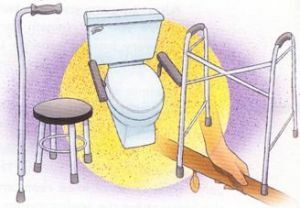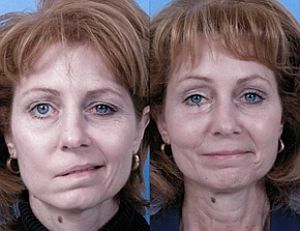 Stroke is one of the most deadly diseases of the 21st century. If several decades ago it was considered an age-related illness, then its "rejuvenation" is happening now.
Stroke is one of the most deadly diseases of the 21st century. If several decades ago it was considered an age-related illness, then its "rejuvenation" is happening now.
Stroke is the destruction of brain tissue due to insufficient blood and oxygen supply.
The development of the destructive process occurs suddenly and causes damage to the brain tissue.
Contents of
- What are the causes of
- ? How long does it take to recover from a stroke?
- What functions need to be restored?
- Is speech restored after a stroke?
- Motion restoration
- Restoration of swallowing
- Restoration of intestine
- Restoring memory
- Restoring vision
- Restoring facial asymmetry
- Rehabilitation centers
- Life after illness
- Is it possible to fully recover?
To which violations the disease causes
The symptomatology of violations against a stroke depends on the location of lesions and is characterized by:
- occurrence of stupor;
- by opacity or loss of consciousness;
- paralysis of the limbs;
- deterioration or loss of coordination;
- coma.
The destruction of the right hemisphere leads:
- to left paralysis;
- impaired spatial perception;
- memory loss.
The destruction of the left hemisphere leads:
- to right-sided paralysis;
- to speech distortion;
- forgetting words.
How long does it take to recover from a stroke?
The process of post-stroke recovery lasts differently.
In water cases, abilities( both mental and physical) return to the patient during the first months after the disease. Others need more time. 
But, unfortunately, most of the consequences remain for life. And here the most important is the qualified assistance of specialists, as well as the support of relatives.
After a stroke, life goes on, do not despair, because with the proper perseverance and the appropriate attitude, it is possible to restore the habitual way of life.
For this it is necessary to follow the recommendations:
- regularly visit a doctor;
- daily measure pressure;
- provide the necessary physical load on the affected limbs;
- to follow a diet;
- exclude alcohol;Do not smoke
- .
What functions need to be restored
After the end of the acute crisis phase, the complex recovery of the body must be started immediately.
Is speech restored after a stroke?
The process of speech restoration - a long( about 3-4 years), painstaking and requires teamwork with a specialist.
Restoration classes require regular basis. The best option - to conduct exercises, sitting in front of the mirror.
Principles of speech restoration:
- should use simple phrases;
- slowly and clearly pronounce the words;
- patient to give time to understand what has been said;
- ask questions that involve monosyllabic answers: "yes" or "no";
- develop fine motor skills;

- to train the muscles of the tongue and face;
- use associative logopedic cards with images of objects and separately with signatures to them;
- the patient should learn to compare pictures with the inscriptions;
- learn to write and read the phrases you just recorded.
And, of course, you need a lot of patience, perseverance and faith in the successful recovery.
Restoring the movement of
The primary task for the patient is to restore the motor activity.
It goes through several stages:
- On the next day after the stroke, it is necessary to start passive physical training, including flexion-extensor, rotational movements of the limbs, and the removal of arms and legs to the sides. Movements should be measured, not delivering discomfort.
- In the supine position - ask the patient to do the exercises with his eyes: move the view up and down, to the sides, do rotational movements and blink.
- For a short time the patient needs to sit down in bed, gradually increasing the interval.
- Learn to stand holding on to the support.
- Learning to walk.
 You can learn more about how to recover from a stroke at home by reading our material.
You can learn more about how to recover from a stroke at home by reading our material.
In what cases does coma occur after a stroke? What you need to do in this case before the arrival of an ambulance.
Restoration of swallowing
Loss of sensitivity functions during chewing and swallowing is not uncommon for stroke patients. To restore these functions it is necessary:
- to do exercises to strengthen the muscles of the tongue and lips;
- select food that can be chewed and swallowed without difficulty, and it should be comfortable temperature with
- an appetizing aroma;
- to carry out the process of feeding exclusively in a sitting posture.
Restoration of the intestine
 Prolonged absence of movement leads to extinction of the intestinal perelstatic function and the appearance of constipation.
Prolonged absence of movement leads to extinction of the intestinal perelstatic function and the appearance of constipation.
To prevent this, the following procedures should be performed:
- for rapid evacuation of the intestine - to make enemas and to give a laxative;
- then switch to "slow laxatives", effective after 10-12 hours;
- to follow a diet: exclude chocolate, flour, rice, whole milk, meat;
- to increase the intake of fiber-rich foods: fruits, vegetables, dried fruits, cereals, sunflower
- and olive oil, berries, fermented milk products.
Memory recovery
To restore the patient to a full life, an important factor is the restoration of memory. To do this, you need to apply maximum patience, love and effort:
- play finger games, focusing the patient's attention on finger manipulation;
- repeat with the patient and study simple poems;
- recall together funny experiences from life;
- ask simple questions;
- invent names, city names, etc.;
- create familiar visual images( for example, the smell of toilet water can remind a patient something);
- does not tell a person about his illness.
Vision recovery
The degree of vision loss is directly proportional to the nature of the stroke. And here can not be irresponsible to the recovery process, otherwise the patient and at all can blind .
The treatment options are as follows:
- at the initial stage - to conduct gymnastics for the eyes, recommended by an ophthalmologist;
- treatment with medication - apply only if the previous method has not been successful;
- prompt resolution of the problem( with the consent of the patient).
Recovery of facial asymmetry
Very often, the result of a stroke is partial or complete paralysis of the facial muscles, which is expressed in the asymmetry of the face.
To strengthen and restore their mobility, it is necessary to perform a set of exercises:
- smoothly move the jaws from side to side;
- try to smile with a "wry" smile( lifting only the corners of the lips);
- alternately smile then left, then right corner of the mouth;
- alternately wink at one or the other eye.
Rehabilitation centers
 In Russia, there are a number of rehabilitation centers after a stroke, many of them provide services for free.
In Russia, there are a number of rehabilitation centers after a stroke, many of them provide services for free.
Their successful functioning is based on the joint work of specialists and the implementation of rehabilitation courses at home by the patient.
The most famous medical institutions dealing with recovery after a stroke.
Centers for rehabilitation after a stroke in Moscow:
- NMHTS them. N.I.Pirogova;
- CDB rehabilitative treatment;
- GAU "NPC of medical and social rehabilitation of disabled people";
- ChC "Three Sisters";
- «Clinic of BS».
In St. Petersburg:
- CR in the City Clinical Hospital City Hospital No. 40;
- GB № 38 them. NA Semashko;
- IPC them. N.I.Pirogov.
Rehabilitation center in Krasnoyarsk: Siberian CC FMBA of Russia.
In Voronezh:
- "Alternative +";
- medical center of kinesitherapy of Dr. Bubnovsky;
- LLC MEDHELP;
In Chelyabinsk:
- neurological clinic of Dr. ID.Bubnovoy;
- Clinic of Restorative Medicine.
Similar centers can be found throughout Russia: in Yekaterinburg, Novosibirsk, Samara, Kazan, Omsk, Ufa, Volgograd, Saratov, etc.
Life after illness
Post-stroke depression develops in 40-60% of patients, is expressed with different strengths and has a chronic course.
Depression, depression, apathy - are its main features. It should be noted that men experience this condition more painfully than women.
For successful recovery of all body functions after a stroke, long rehabilitation is needed at home, a positive attitude of the patient, a change in lifestyle and a favorable environment.
Is it possible to fully recover?
Unfortunately, post-stroke recovery is not fast and very time consuming. And how long will a person who has suffered a stroke depend on himself. 
However, if you follow the advice of a doctor, competently eat, exclude bad habits and carry out drug prevention of the disease, there may be a significant improvement in the quality of life, but is completely cured of the consequences of a stroke, it is not yet possible , although there are rare cases.
Stroke is not a sentence. And support of relatives in this difficult moment of life is a huge stimulus for restoring the habitual way of life of the patient.
And here it is important to stop feeling sorry for yourself and "pick up", then the quality of life will significantly improve.



